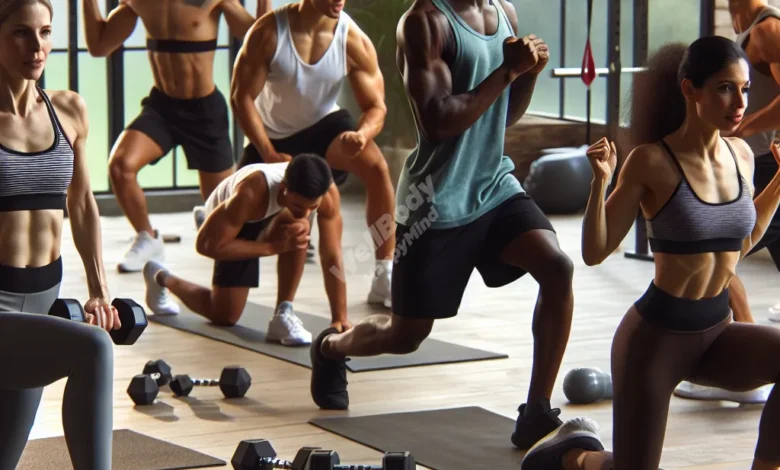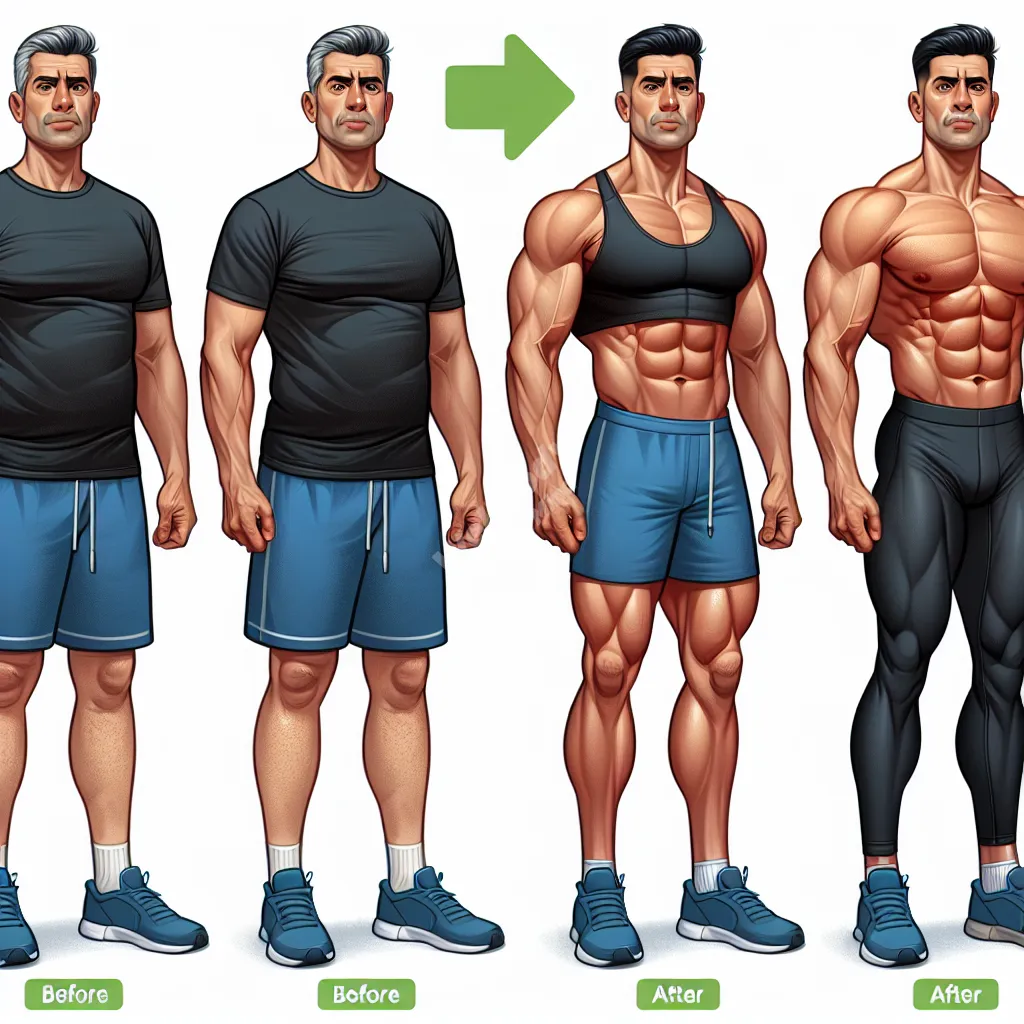Full-Body Fitness: Master Your Balanced Routine

I. Introduction
Did you know that focusing on just one or two muscle groups in your workouts is like trying to drive a car with only two wheels? It might work for a short distance, but it’s not sustainable or efficient in the long run. Welcome to our guide on “A Balanced Approach to Fitness: Structuring Routines for All Major Muscle Groups.”
In this post, we’ll explore how to create a balanced fitness routine that targets all your major muscle groups – your chest, back, shoulders, arms, legs, and core. By the end, you’ll understand why a well-rounded approach is key to achieving your fitness goals and overall health. Get ready to transform your workouts and unlock your body’s full potential!
II. Understanding Major Muscle Groups
A. Overview of the body’s major muscle groups
To create a balanced fitness routine, it’s important to understand the major muscle groups in your body. These include:
- Chest
- Back
- Shoulders
- Arms (biceps and triceps)
- Legs
- Core

B. Functions of each muscle group in daily life
Each of these muscle groups plays a crucial role in your everyday activities:
- Your chest muscles help you push things and hug your loved ones.
- Back muscles support your posture and help you pull objects.
- Shoulder muscles allow you to reach for items on high shelves.
- Arm muscles assist in carrying groceries and lifting objects.
- Leg muscles enable you to walk, run, and climb stairs.
- Core muscles stabilize your body and support all other movements.
C. Benefits of balanced muscle development
Developing all these muscle groups evenly offers several advantages:
- Improved overall strength and functionality
- Better posture and balance
- Reduced risk of injury
- Enhanced athletic performance
- More efficient calorie burning
- Balanced and aesthetically pleasing physique
By focusing on all major muscle groups, you create a strong foundation for a healthy, capable body that can handle the demands of daily life and physical activities with ease.
III. Principles of Balanced Fitness
A. Importance of full-body workouts
Full-body workouts are a cornerstone of a balanced fitness routine. They ensure that all your major muscle groups receive attention, promoting overall strength and preventing muscle imbalances. This approach is especially beneficial for beginners or those with limited time for exercise.
B. Frequency of training each muscle group
For optimal results, aim to train each major muscle group 2-3 times per week. This frequency allows for adequate stimulation and recovery time. Remember, muscles grow and strengthen during rest periods, not during the workout itself.
C. Rest and recovery in a balanced routine
Rest is just as important as the workout itself. Allow at least one full day of rest between training sessions for the same muscle group. This gives your body time to repair and strengthen the muscles you’ve worked.
D. Progressive overload for continuous improvement
To keep making progress, gradually increase the challenge of your workouts over time. This could mean adding more weight, doing more repetitions, or increasing the complexity of exercises.
Here’s a summary of these principles:
| Principle | Key Points |
|---|---|
| Full-body workouts | – Target all major muscle groups – Promote overall strength – Prevent imbalances |
| Training frequency | – 2-3 times per week per muscle group – Balance stimulation and recovery |
| Rest and recovery | – At least one full day between training same muscle group – Essential for muscle growth and strength gains |
| Progressive overload | – Gradually increase challenge over time – Can involve weight, reps, or exercise complexity |
By following these principles, you’ll create a balanced fitness routine that promotes steady progress and helps you avoid common pitfalls like overtraining or neglecting certain muscle groups.
IV. Structuring a Balanced Workout Routine
A. Full-body workout plans
A full-body workout plan is an excellent way to ensure a balanced fitness routine, especially for beginners or those with limited time. Here’s an example of a 3-day full-body split:
- Day 1: Full-body workout
- Day 2: Rest
- Day 3: Full-body workout
- Day 4: Rest
- Day 5: Full-body workout
- Day 6-7: Rest
Each workout would include exercises for all major muscle groups.
B. Upper/lower body split routines
An upper/lower split allows for more focus on specific areas. Here’s a sample 4-day upper/lower split:
- Day 1: Upper body
- Day 2: Lower body
- Day 3: Rest
- Day 4: Upper body
- Day 5: Lower body
- Day 6-7: Rest
This split provides more time for each muscle group per session.
C. Push/pull/legs routines
A push/pull/legs routine is popular among more advanced lifters. Here’s an example of a 6-day push/pull/legs split:
- Day 1: Push (chest, shoulders, triceps)
- Day 2: Pull (back, biceps)
- Day 3: Legs
- Day 4: Push
- Day 5: Pull
- Day 6: Legs
- Day 7: Rest
This split allows for high-frequency training of each muscle group.

D. Customizing routines based on individual goals and schedules
The best routine is one you can stick to consistently. Consider your goals, available time, and preferences when choosing a split. For example:
- If you can only work out 3 days a week, a full-body routine might be best.
- If you enjoy longer workouts but have only 4 days available, an upper/lower split could work well.
- If you’re aiming for maximum muscle growth and can commit to 6 days a week, a push/pull/legs routine might be ideal.
Remember, consistency is key in any balanced fitness routine. Choose a plan that fits your lifestyle and that you enjoy, as this will help you stay committed to your fitness journey.
V. Exercises for Each Major Muscle Group
In this section, we’ll explore exercises for each major muscle group. Remember to start with lighter weights and focus on proper form before increasing the intensity.
A. Chest exercises
- Compound exercises:
• Push-ups
• Bench press
• Dumbbell chest press - Isolation exercises:
• Chest flyes
• Cable crossovers
B. Back exercises
- Compound exercises:
• Pull-ups or assisted pull-ups
• Rows (barbell, dumbbell, or machine)
• Lat pulldowns - Isolation exercises:
• Face pulls
• Reverse flyes
C. Shoulder exercises
- Compound exercises:
• Overhead press (barbell or dumbbell)
• Arnold press - Isolation exercises:
• Lateral raises
• Front raises
• Reverse flyes
D. Arm exercises (biceps and triceps)
- Biceps:
• Bicep curls (barbell, dumbbell, or cable)
• Hammer curls - Triceps:
• Tricep dips
• Tricep pushdowns
• Overhead tricep extensions
E. Leg exercises
- Compound exercises:
• Squats
• Deadlifts
• Lunges - Isolation exercises:
• Leg extensions
• Hamstring curls
• Calf raises
F. Core exercises
- Planks
- Russian twists
- Bicycle crunches
- Dead bugs
- Leg raises

For a balanced fitness routine, aim to include a mix of compound and isolation exercises for each muscle group. Compound exercises work multiple muscle groups at once and should form the foundation of your workout. Isolation exercises can help target specific areas for additional development or balance.
VI. Incorporating Cardiovascular Exercise
A. Importance of cardio in a balanced fitness routine
Cardiovascular exercise is a crucial component of any balanced fitness routine. It improves heart health, boosts endurance, aids in weight management, and complements your strength training efforts. Incorporating cardio into your routine helps create a well-rounded approach to fitness.
B. Types of cardio exercises
There are various types of cardio exercises to choose from:
- High-Intensity Interval Training (HIIT)
- Steady-state cardio
- Low-impact cardio
Here’s a comparison of these cardio types:
| Cardio Type | Description | Benefits | Examples |
|---|---|---|---|
| HIIT | Short bursts of intense activity followed by rest periods | – Time-efficient – Boosts metabolism – Improves endurance | – Sprinting – Burpees – Jump rope intervals |
| Steady-state | Continuous moderate-intensity activity | – Improves endurance – Less stress on joints – Good for beginners | – Jogging – Cycling – Swimming |
| Low-impact | Exercises that put less stress on joints | – Suitable for all fitness levels – Lower risk of injury – Good for active recovery | – Walking – Elliptical machine – Rowing |
C. Balancing cardio with strength training
To maintain a balanced fitness routine, consider these tips for combining cardio and strength training:
- Perform cardio and strength training on separate days if possible
- If done on the same day, do strength training first for optimal performance
- Start with 2-3 cardio sessions per week, 20-30 minutes each
- Gradually increase duration and intensity as your fitness improves
- Choose cardio activities you enjoy to stay motivated
- Mix up your cardio exercises to prevent boredom and work different muscle groups
Remember, the goal is to find a balance that supports your overall fitness goals without overtraining or neglecting any aspect of your health. Listen to your body and adjust your routine as needed.

VII. Flexibility and Mobility Training
A. Role of flexibility in overall fitness
Flexibility and mobility training are often overlooked but are crucial components of a balanced fitness routine. They help:
- Improve range of motion
- Reduce risk of injury
- Enhance performance in other exercises
- Alleviate muscle tension and soreness
- Promote better posture
B. Stretching exercises for each major muscle group
Here’s a list of key stretches for each muscle group:
- Chest: Doorway chest stretch
- Back: Cat-cow stretch, child’s pose
- Shoulders: Shoulder rolls, arm circles
- Arms: Tricep stretch, bicep stretch
- Legs:
- Quadriceps: Standing quad stretch
- Hamstrings: Seated forward bend
- Calves: Wall calf stretch
- Core: Cobra pose, supine twist
Remember to hold each stretch for 15-30 seconds and breathe deeply.
C. Incorporating yoga or Pilates for improved flexibility and core strength
Yoga and Pilates are excellent ways to improve both flexibility and core strength:
- Yoga:
- Improves flexibility, balance, and mindfulness
- Poses like downward dog, warrior series, and sun salutations benefit overall body flexibility
- Pilates:
- Focuses on core strength, posture, and controlled movements
- Exercises like the hundred, roll-up, and plank variations enhance core stability and flexibility
To incorporate these into your balanced fitness routine:
- Add a 10-15 minute stretching session after your workouts
- Dedicate one day a week to a full yoga or Pilates session
- Start your day with a quick stretching routine to improve mobility
Remember, consistency is key. Regular stretching and mobility work will lead to noticeable improvements in your overall fitness and daily comfort.

VIII. Nutrition for Balanced Muscle Development
A balanced fitness routine isn’t complete without proper nutrition. What you eat plays a crucial role in muscle development, recovery, and overall health.
A. Importance of protein intake
- Protein is essential for muscle repair and growth
- Aim for 1.6 to 2.2 grams of protein per kilogram of body weight daily
- Good sources: lean meats, fish, eggs, dairy, legumes, and plant-based protein sources
B. Role of carbohydrates and fats
- Carbohydrates:
- Provide energy for workouts
- Help with muscle recovery
- Choose complex carbs like whole grains, fruits, and vegetables
- Fats:
- Support hormone production
- Aid in nutrient absorption
- Focus on healthy fats from sources like avocados, nuts, seeds, and olive oil
C. Hydration for optimal muscle function
- Proper hydration is crucial for muscle function and recovery
- Aim for at least 8 glasses of water per day
- Increase intake during and after workouts
D. Pre and post-workout nutrition
Key nutritional points:
- Pre-workout:
- Eat a balanced meal 2-3 hours before exercise
- Include complex carbs and lean protein
- Example: Whole grain toast with peanut butter and banana
- Post-workout:
- Consume protein within 30 minutes after exercise
- Include carbs to replenish energy stores
- Example: Greek yogurt with berries and granola
- General tips:
- Eat a variety of colorful fruits and vegetables
- Choose whole foods over processed options
- Consider consulting a nutritionist for personalized advice
Remember, nutrition is highly individual. These guidelines provide a starting point, but you may need to adjust based on your specific needs, goals, and how your body responds.

IX. Tracking Progress and Adjusting Your Routine
A. Methods for measuring progress
Tracking your progress is essential for staying motivated and ensuring your balanced fitness routine is effective. Here are some ways to measure your progress:
- Strength gains:
• Keep a workout log to track weights lifted and reps completed
• Note improvements in form and range of motion - Body measurements:
• Use a tape measure for key areas like chest, waist, hips, and arms
• Take measurements every 4-6 weeks - Progress photos:
• Take photos from the front, side, and back
• Wear similar clothing and use consistent lighting
• Take new photos every 4-6 weeks - Performance metrics:
• Track improvements in cardio endurance (e.g., running distance or time)
• Note increases in flexibility (e.g., how far you can reach in stretches) - Body composition:
• Use body fat calipers or smart scales for approximate body fat percentage
• Consider professional DEXA scans for more accurate results
B. When and how to modify your routine
It’s important to adjust your routine periodically to avoid plateaus and continue making progress:
- Modify every 4-6 weeks or when progress slows
- Gradually increase weights or reps in strength training
- Change up exercise variations (e.g., switch from barbell to dumbbell exercises)
- Alter workout splits if your schedule or goals change
- Adjust nutrition as needed based on your progress and goals
C. Overcoming plateaus in a balanced fitness approach
If you hit a plateau:
- Reassess your nutrition: Ensure you’re eating enough to support your activity level
- Get more rest: Adequate sleep is crucial for recovery and progress
- Try new exercises: Introduce variety to challenge your muscles in different ways
- Adjust your tempo: Experiment with slower or faster reps
- Consider periodization: Cycle between different training intensities and volumes
- Seek professional guidance: A personal trainer can help identify areas for improvement
Remember, progress isn’t always linear. Stay patient and consistent with your balanced fitness routine, and you’ll continue to see results over time.

X. Common Mistakes to Avoid
Let’s address some common mistakes people make when trying to maintain a balanced fitness routine. We’ll present this information in a Q&A format to make it easy to understand and remember.
Q: What’s wrong with overtraining certain muscle groups?
A: Overtraining can lead to:
• Muscle imbalances
• Increased risk of injury
• Slower overall progress
• Burnout and decreased motivation
To avoid this, stick to your balanced routine and allow adequate rest between workouts.
Q: Why is neglecting specific muscle groups a problem?
A: Neglecting certain muscles can result in:
• Weaknesses in your overall fitness
• Posture problems
• Increased risk of injury in daily activities
Ensure your routine includes exercises for all major muscle groups to maintain balance.
Q: How can improper form and technique hinder progress?
A: Poor form can:
• Reduce the effectiveness of exercises
• Increase the risk of injury
• Lead to developing bad habits
Always prioritize proper form over lifting heavier weights or doing more reps. If unsure, consult a fitness professional or watch reputable tutorial videos.
Q: What happens if you don’t get adequate rest and recovery?
A: Insufficient rest can lead to:
• Decreased performance
• Increased risk of injury
• Slower muscle growth and repair
• Mental fatigue and burnout
Remember, muscles grow during rest periods, not during workouts. Ensure you’re getting enough sleep and taking rest days as needed.
Q: Is it a mistake to expect quick results?
A: Yes, because:
• Fitness is a journey, not a destination
• Unrealistic expectations can lead to disappointment and giving up
• Sustainable progress takes time and consistency
Focus on forming healthy habits and enjoying the process rather than fixating on rapid results.
Q: What if you don’t adjust your routine over time?
A: Sticking to the same routine indefinitely can:
• Lead to plateaus in progress
• Cause boredom and decreased motivation
• Limit overall fitness development
Regularly assess and adjust your routine to keep challenging yourself and making progress.
By avoiding these common mistakes, you’ll be better equipped to maintain a truly balanced fitness routine and achieve long-term success in your fitness journey.

XI. Conclusion
Congratulations! You’ve now gained a comprehensive understanding of how to create and maintain a balanced fitness routine. Let’s recap the key points we’ve covered:
- A balanced approach to fitness involves working all major muscle groups: chest, back, shoulders, arms, legs, and core.
- Structuring your workouts with full-body, upper/lower splits, or push/pull/legs routines can help ensure balanced muscle development.
- Incorporating a mix of strength training, cardiovascular exercise, and flexibility work is crucial for overall fitness.
- Proper nutrition and hydration play vital roles in supporting your balanced fitness routine.
- Tracking progress and adjusting your routine over time helps maintain steady improvement and prevents plateaus.
Remember, the journey to fitness is not a sprint, but a marathon. Consistency is your most powerful tool. Even small, regular efforts add up to significant changes over time. As you implement your balanced fitness routine, keep these points in mind:
- Be patient with yourself. Progress takes time and doesn’t always follow a straight line.
- Listen to your body. Rest when you need to and adjust your routine if something doesn’t feel right.
- Celebrate small victories along the way. Every workout completed is a step towards your goals.
- Enjoy the process. Choose activities you like, as you’re more likely to stick with them long-term.
- Don’t compare your journey to others. Everyone’s fitness path is unique.
By following a balanced fitness routine, you’re not just working towards a healthier body – you’re investing in a better quality of life. You’re building strength, endurance, and flexibility that will serve you in all areas of your life.
So, are you ready to start your balanced fitness journey? Remember, the best time to start is now. Take that first step, no matter how small, and keep moving forward. Your future self will thank you for the effort you put in today.

XII. Additional Resources
To support your balanced fitness journey, here’s a curated list of helpful resources:
- Books:
- “Starting Strength” by Mark Rippetoe
- “The New Encyclopedia of Modern Bodybuilding” by Arnold Schwarzenegger
- “Bigger Leaner Stronger” by Michael Matthews
- Websites:
- ExRx.net: Comprehensive exercise library and fitness information
- Bodybuilding.com: Workout plans, nutrition advice, and supplement information
- MyFitnessPal.com: Nutrition tracking and community support
- Mobile Apps:
- Strong: For tracking workouts and progress
- Nike Training Club: Offers a variety of workout routines
- MyFitnessPal: For tracking nutrition and calories
- YouTube Channels:
- AthleanX: For in-depth exercise tutorials and fitness advice
- FitnessBlender: Offers a wide range of free workout videos
- Yoga with Adriene: Great for beginners looking to incorporate yoga
- Podcasts:
- “Mind Pump”: Fitness and nutrition information
- “The Muscle Expert Podcast”: Interviews with fitness experts
- “The Jillian Michaels Show”: General health and wellness advice
Remember, while these resources can provide valuable information and inspiration, it’s always best to consult with a healthcare provider or certified fitness professional before starting any new exercise program, especially if you have any pre-existing health conditions.
This concludes our comprehensive guide on “A Balanced Approach to Fitness: Structuring Routines for All Major Muscle Groups.” We hope this information helps you on your journey to a healthier, fitter you. If you have any questions or need clarification on any part of this guide, please don’t hesitate to ask. Good luck with your balanced fitness routine!



